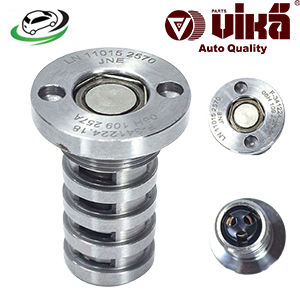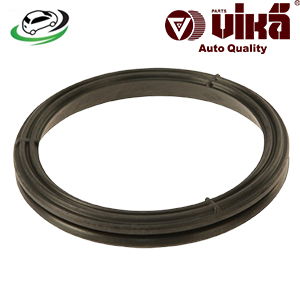-17%
Get Front Camshaft Seal Audi A3 8P/B8 A4/ VW EOS/CC/Golf V/Golf VI/Jetta VI/Passat B6 06H103483D
The camshaft seal, also known as the camshaft oil seal, is a small but crucial component in an internal combustion engine. It is responsible for preventing oil leaks at the point where the camshaft exits the engine block or cylinder head. Despite its size, the camshaft seal plays a significant role in maintaining engine integrity, oil levels, and overall performance. This guide will explore the function, construction, benefits, signs of failure, diagnostics, and maintenance of the camshaft seal in detail.
Function of the Camshaft Seal
The primary function of the camshaft seal is to prevent engine oil from leaking out of the engine where the camshaft protrudes through the cylinder head or engine block. The camshaft is responsible for controlling the opening and closing of the engine’s valves, and it must extend outside the engine to connect with the timing components, such as the timing belt or chain.
- Oil Containment:
- Prevention of Leaks: The camshaft seal ensures that engine oil, which lubricates the camshaft and other internal components, does not escape from the engine. Maintaining the correct oil level is vital for the smooth operation of the engine.
- Sealing Function: The seal fits snugly around the camshaft, providing a tight seal between the rotating camshaft and the stationary engine block or cylinder head. This prevents oil from leaking out while allowing the camshaft to rotate freely.
- Protection of Timing Components:
- Timing Belt/Chain: The camshaft seal prevents oil from contaminating the timing belt or chain. Oil contamination can cause these components to degrade prematurely, leading to potential timing issues and engine damage.
- Preventing Slippage: By keeping oil away from the timing belt or chain, the seal helps prevent slippage, ensuring that the engine’s timing remains accurate.
- Maintaining Engine Cleanliness:
- Preventing Oil Spray: Without a properly functioning camshaft seal, engine oil could spray out, leading to oil buildup on surrounding engine components. This can create a mess under the hood and make it difficult to detect other potential issues.
- Reducing Contamination: The seal also helps keep contaminants such as dirt and debris out of the engine, contributing to the overall cleanliness and longevity of the engine components.
Construction of the Camshaft Seal
The camshaft seal is typically made from durable materials designed to withstand high temperatures, pressure, and exposure to engine oil. Its construction includes several key elements:
- Material:
- Rubber or Elastomer: Most camshaft seals are made from high-quality rubber or elastomeric materials that are resistant to heat, oil, and chemical exposure. These materials provide flexibility and durability.
- PTFE (Polytetrafluoroethylene): Some seals are made from PTFE, a material known for its low friction and high resistance to wear and tear. PTFE seals are often used in high-performance or heavy-duty applications.
- Metal Reinforcement:
- Steel Spring: The camshaft seal often includes a small steel spring embedded within the rubber or elastomer. This spring helps maintain a tight fit around the camshaft, ensuring a secure seal even under varying pressure and temperature conditions.
- Lip Design:
- Single-Lip or Double-Lip: The seal may have a single or double lip design. The lip(s) of the seal are in direct contact with the camshaft surface, creating the necessary seal to prevent oil leaks. Double-lip seals offer enhanced sealing capabilities by providing an additional barrier against oil leakage.
- Sealing Surface:
- Smooth Contact Area: The inner surface of the camshaft seal is designed to be smooth and precise, allowing it to maintain constant contact with the camshaft while minimizing wear and friction.
Benefits of a Properly Functioning Camshaft Seal
A properly functioning camshaft seal offers several key benefits that contribute to the overall health and performance of the engine:
- Prevention of Oil Leaks:
- Maintaining Oil Levels: The camshaft seal prevents oil from leaking out of the engine, helping to maintain the proper oil level. Adequate oil levels are essential for lubricating engine components and preventing excessive wear.
- Avoiding Oil Loss: By preventing oil leaks, the seal helps avoid the need for frequent oil top-ups, saving time and money on maintenance.
- Protection of Engine Components:
- Timing Components: A functioning camshaft seal prevents oil from contaminating the timing belt or chain, ensuring that these components remain in good condition and operate efficiently.
- Prevention of Engine Damage: By keeping the timing components clean and dry, the seal helps prevent potential engine damage caused by improper timing or belt slippage.
- Reduced Risk of Engine Overheating:
- Oil as a Coolant: Engine oil also acts as a coolant, helping to dissipate heat from the engine. A properly sealed engine retains oil, ensuring that there is enough oil to assist in cooling the engine and preventing overheating.
- Maintaining Pressure: The camshaft seal helps maintain the internal oil pressure, which is crucial for the efficient circulation of oil and the prevention of hotspots within the engine.
- Extended Engine Life:
- Minimized Wear: By preventing oil leaks and maintaining proper lubrication, the camshaft seal helps minimize wear and tear on the engine’s moving parts, potentially extending the engine’s lifespan.
- Cleaner Engine: A properly sealed engine remains cleaner, reducing the risk of dirt and debris entering the engine and causing damage to sensitive components.
Signs of a Failing Camshaft Seal
A failing camshaft seal can lead to various engine performance issues and should be addressed promptly. Common signs of a failing camshaft seal include:
- Oil Leaks:
- Visible Leaks: One of the most obvious signs of a failing camshaft seal is visible oil leaks around the camshaft area, especially where the camshaft exits the engine block or cylinder head.
- Oil Spots: Oil spots or puddles under the vehicle, particularly near the engine, can indicate a leak from the camshaft seal.
- Low Oil Levels:
- Frequent Top-Ups: If you find yourself frequently topping up the engine oil, it may be due to a leaking camshaft seal that is allowing oil to escape.
- Oil Warning Light: The oil warning light on the dashboard may illuminate if the oil level drops too low due to a leak.
- Oil Contamination on Timing Components:
- Oily Timing Belt or Chain: If oil is found on the timing belt or chain, it may be due to a leaking camshaft seal. This can cause the belt or chain to degrade prematurely or slip, leading to potential timing issues.
- Engine Misfires or Performance Issues:
- Engine Misfires: Oil contamination of the timing belt or chain can lead to improper engine timing, causing the engine to misfire or run roughly.
- Reduced Performance: A failing camshaft seal can contribute to a decrease in engine performance, including reduced power and acceleration.
- Burning Oil Smell:
- Odor: If oil leaks onto hot engine components, such as the exhaust manifold, it can cause a burning oil smell. This is a clear indicator that oil is leaking from somewhere, potentially from the camshaft seal.
Diagnosing and Replacing a Faulty Camshaft Seal
Diagnosing a faulty camshaft seal typically involves visual inspection and, if necessary, further diagnostic steps:
- Visual Inspection:
- Check for Leaks: Inspect the area around the camshaft seal for signs of oil leaks. Look for oil buildup, stains, or wetness around the seal location.
- Inspect Timing Components: If possible, inspect the timing belt or chain for signs of oil contamination.
- Oil Level Check:
- Monitor Oil Levels: Check the engine oil level regularly. A consistently low oil level without any external leaks may indicate a leaking camshaft seal.
- Replacing the Camshaft Seal:
- Removal of Timing Components: Replacing the camshaft seal typically requires removing the timing belt or chain and possibly other components, depending on the engine design.
- Seal Replacement: Once the old seal is removed, the new seal can be installed, ensuring it is seated properly and securely around the camshaft.
- Reinstallation: After the seal is replaced, the timing components and any other parts that were removed can be reinstalled, and the engine should be tested to ensure proper operation.
Maintenance of the Camshaft Seal
Proper maintenance of the camshaft seal involves regular checks and timely replacement if necessary:
- Regular Inspections:
- Routine Checks: During regular vehicle maintenance, inspect the camshaft seal and surrounding area for signs of leaks or wear.
- Monitor Oil Levels: Keep an eye on oil levels and check for any unexplained drops that could indicate a leak.
- Timely Replacement:
- Replace During Timing Belt Service: It is often recommended to replace the camshaft seal when performing a timing belt or chain service, as the seal is easily accessible during this procedure.
- Use Quality Seals: When replacing the camshaft seal, use a high-quality seal, preferably an OEM part or a reputable aftermarket equivalent, to ensure long-lasting performance.
- Address Issues Promptly:
- Respond to Symptoms: If you notice any signs of a failing camshaft seal, such as oil leaks or a burning oil smell, address the issue promptly to avoid further damage to the engine.
Follow us on Facebook for more parts.



